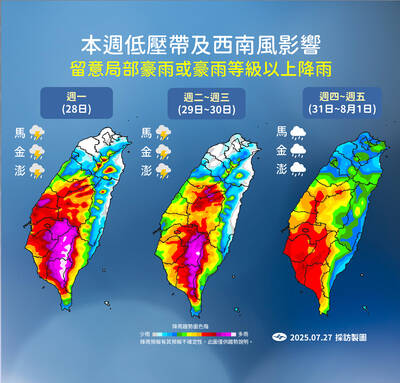Curdlan gum, a tasteless food additive used to enhance the texture of processed food, is harmless to humans, although “overdoses” could compromise one’s ability to taste food and even cause indigestion, a Department of Health official said yesterday.
Hsieh Ting-hung (謝定宏), deputy director of the department’s Bureau of Food Safety, said that curdlan gum — the generic name for a beta-1,3-D-glucan produced by agrobacterium biobar, a non- pathogenic bacterium approved as a food additive in 1996 — is tasteless and produces retortable freezable food elastic gels.
Upon heating at higher temperatures of about 55˚C, curdlan gum produces more resilient irreversible gels, Hsieh said, adding that it is widely used by domestic food processors to improve texture and crispness.
Beta-glucans are insoluble fibers and therefore have no caloric value. Insoluble fibers have been shown to prevent intestinal cancer and enhance immune response. So far, curdlan is the most concentrated beta-glucan known, Hsieh said.
He made the remarks in response to a report published in the Chinese-language media claiming that curdlan gum had been found to have been added to fish and seafood paste — a substance used to prepare fish and seafood cakes — as a means of cutting costs.
He said food processing companies had not broken any laws by adding curdlan gum to fish paste or fish cakes, as long as it is clearly indicated on the packaging.

The Central Weather Administration (CWA) today issued a "tsunami watch" alert after a magnitude 8.7 earthquake struck off the Kamchatka Peninsula in northeastern Russia earlier in the morning. The quake struck off the east coast of the Kamchatka Peninsula at 7:25am (Taiwan time) at a depth of about 19km, the CWA said, citing figures from the Pacific Tsunami Warning Center. The CWA's Seismological Center said preliminary assessments indicate that a tsunami could reach Taiwan's coastal areas by 1:18pm today. The CWA urged residents along the coast to stay alert and take necessary precautions as waves as high as 1m could hit the southeastern

The National Museum of Taiwan Literature is next month to hold an exhibition in Osaka, Japan, showcasing the rich and unique history of Taiwanese folklore and literature. The exhibition, which is to run from Aug. 10 to Aug. 20 at the city’s Central Public Hall, is part of the “We Taiwan” at Expo 2025 series, highlighting Taiwan’s cultural ties with the international community, National Museum of Taiwan Literature director Chen Ying-fang (陳瑩芳) said. Folklore and literature, among Taiwan’s richest cultural heritages, naturally deserve a central place in the global dialogue, Chen said. Taiwan’s folklore would be immediately apparent at the entrance of the

Speeding and badly maintained roads were the main causes of a school bus accident on a rainy day in Taipei last year that severely injured two people and left 22 with minor injuries, the Taiwan Transportation and Safety Board said. On March 11 last year, a Kang Chiao International School bus overturned inside the Wenshan Tunnel (文山隧道) on the northbound lane of the Xinyi Expressway. The tour bus, owned by Long Lai Co, exceeded the speed limit after entering the tunnel, the board’s investigation found. Sensing that the rear of the vehicle was swaying, the driver attempted to use the service and exhaust

Central and southern Taiwan are to see increasingly heavy rainfall from last night through Friday due to the effects of a low-pressure system and southwesterly winds, the Central Weather Administration (CWA) said. CWA forecaster Liu Pei-teng (劉沛滕) said Tropical Storm Co-May had weakened into a low-pressure system on Saturday, but that it strengthened again into a tropical depression (TD 11) near the seas around Japan's Ryukyu Islands due to favorable environmental conditions. The tropical depression is expected to persist for two to three days, moving west-northwest by this afternoon and reaching China's Zhejiang through the East China Sea tomorrow,